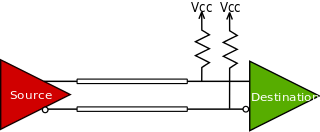
Synchronous Optical Networking (SONET) and Synchronous Digital Hierarchy (SDH) are standardized protocols that transfer multiple digital bit streams synchronously over optical fiber using lasers or highly coherent light from light-emitting diodes (LEDs). At low transmission rates data can also be transferred via an electrical interface. The method was developed to replace the plesiochronous digital hierarchy (PDH) system for transporting large amounts of telephone calls and data traffic over the same fiber without the problems of synchronization.

Fiber Distributed Data Interface (FDDI) is a standard for data transmission in a local area network. It uses optical fiber as its standard underlying physical medium, although it was also later specified to use copper cable, in which case it may be called CDDI, standardized as TP-PMD, also referred to as TP-DDI.
A frame is a digital data transmission unit in computer networking and telecommunication. In packet switched systems, a frame is a simple container for a single network packet. In other telecommunications systems, a frame is a repeating structure supporting time-division multiplexing.

Time-division multiplexing (TDM) is a method of transmitting and receiving independent signals over a common signal path by means of synchronized switches at each end of the transmission line so that each signal appears on the line only a fraction of time in an alternating pattern. It can be used when the bit rate of the transmission medium exceeds that of the signal to be transmitted. This form of signal multiplexing was developed in telecommunications for telegraphy systems in the late 19th century, but found its most common application in digital telephony in the second half of the 20th century.

InfiniBand (IB) is a computer networking communications standard used in high-performance computing that features very high throughput and very low latency. It is used for data interconnect both among and within computers. InfiniBand is also used as either a direct or switched interconnect between servers and storage systems, as well as an interconnect between storage systems. It is designed to be scalable and uses a switched fabric network topology. By 2014, it was the most commonly used interconnect in the TOP500 list of supercomputers, until about 2016.
Fibre Channel (FC) is a high-speed data transfer protocol providing in-order, lossless delivery of raw block data. Fibre Channel is primarily used to connect computer data storage to servers in storage area networks (SAN) in commercial data centers.
A leased line is a private telecommunications circuit between two or more locations provided according to a commercial contract. It is sometimes also known as a private circuit, and as a data line in the UK. Typically, leased lines are used by businesses to connect geographically distant offices.
In computer networking and telecommunications, a pseudowire is an emulation of a point-to-point connection over a packet-switched network (PSN).
The Optical Internetworking Forum (OIF) is a prominent non-profit consortium that was founded in 1998. It promotes the development and deployment of interoperable computer networking products and services through implementation agreements (IAs) for optical networking products and component technologies including SerDes devices.

A passive optical network (PON) is a fiber-optic telecommunications technology for delivering broadband network access to end-customers. Its architecture implements a point-to-multipoint topology in which a single optical fiber serves multiple endpoints by using unpowered (passive) fiber optic splitters to divide the fiber bandwidth among the endpoints. Passive optical networks are often referred to as the last mile between an Internet service provider (ISP) and its customers. Many fiber ISPs prefer this technology.

Current mode logic (CML), or source-coupled logic (SCL), is a digital design style used both for logic gates and for board-level digital signaling of digital data.
A digital cross-connect system is a piece of circuit-switched network equipment, used in telecommunications networks, that allows lower-level TDM bit streams, such as DS0 bit streams, to be rearranged and interconnected among higher-level TDM signals, such as DS1 bit streams. DCS units are available that operate on both older T-carrier/E-carrier bit streams, as well as newer SONET/SDH bit streams.
Fibre Channel Protocol (FCP) is the SCSI interface protocol utilising an underlying Fibre Channel connection. The Fibre Channel standards define a high-speed data transfer mechanism that can be used to connect workstations, mainframes, supercomputers, storage devices and displays. FCP addresses the need for very fast transfers of large volumes of information and could relieve system manufacturers from the burden of supporting a variety of channels and networks, as it provides one standard for networking, storage and data transfer. Some Fibre Channel characteristics are:

An optical transport network (OTN) is a digital wrapper that encapsulates frames of data, to allow multiple data sources to be sent on the same channel. This creates an optical virtual private network for each client signal.
McASP is an acronym for Multichannel Audio Serial Port, a communication peripheral found in Texas Instruments family of digital signal processors (DSPs) and Microcontroller Units (MCUs).
The McASP functions as a general-purpose audio serial port optimized for the needs of multichannel audio applications. Depending on the implementation, the McASP may be useful for time-division multiplexed (TDM) stream, Inter-Integrated Sound (I2S) protocols, and intercomponent digital audio interface transmission (DIT). However, some implementations are limited to supporting just the Inter-Integrated Sound (I2S) protocol.
The McASP consists of transmit and receive sections that may operate synchronized, or completely independently with separate master clocks, bit clocks, and frame syncs, and using different transmit modes with different bit-stream formats. The McASP module also includes up to 16 serializers that can be individually enabled to either transmit or receive. In addition, all of the McASP pins can be configured as general-purpose input/output (GPIO) pins.
Multiservice Switch (MSS) is originally a Nortel line of routers, historically called Passport, designed for carrier core and edge routing. They run the Passport Carrier Release operating system. The MSS has a significant installed base, with over 40,000 switches sold.
The ADAT Lightpipe, officially the ADAT Optical Interface, is a standard for the transfer of digital audio between equipment. It was originally developed by Alesis but has since become widely accepted, with many third party hardware manufacturers including Lightpipe interfaces on their equipment. The protocol has become so popular that the term ADAT is now often used to refer to the transfer standard rather than to the Alesis Digital Audio Tape itself.
TFI-5 in computer networking is a standardized TDM Fabric to Framer Interface by the Optical Internetworking Forum (OIF) that allow both framer components and switch components from multiple vendors to inter-operate facilitating the development of add/drop multiplexers, TDM cross connect and grooming switches. The TFI-5 standard includes link integrity monitoring, connection management and mapping mechanisms for both SONET/SDH and non-SONET/SDH clients such as Ethernet and Fibre Channel.
H.100 and H.110 are legacy telephony equipment standard published by the ECTF that allow the transport of up to 4096 simplex channels of voice or data on one connector or ribbon cable. H.100 is implemented using Multi-Channeled Buffered Serial Ports (McBSP), typically included as a DSP peripheral. McBSP, also known as TDM Serial ports are special serial ports that support multiple channels by using Time-division multiplexing (TDM).
Generalized Multi-Protocol Label Switching (GMPLS) is a protocol suite extending MPLS to manage further classes of interfaces and switching technologies other than packet interfaces and switching, such as time-division multiplexing, layer-2 switching, wavelength switching and fiber-switching.






